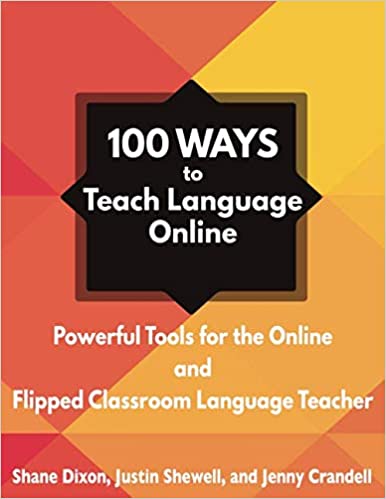I am sure many teachers have seen, or at least heard of Maslow's hierarchy of needs. In the education world, this hierarchy is the basis for policy decisions like offering free or reduced lunch and breakfasts at schools, and many other decisions made in the best-interest of students. For those who are not familiar with Maslow's hierarchy of needs, the basic premis is that for an individual to be able to achieve self-actualization, which is where learning takes place, all the more basic needs need to be met. If a student is hungry or homeless, they won't care much about basic algebra, right? If they don't have love or respect, then it is harder for them to care about improving themselves.
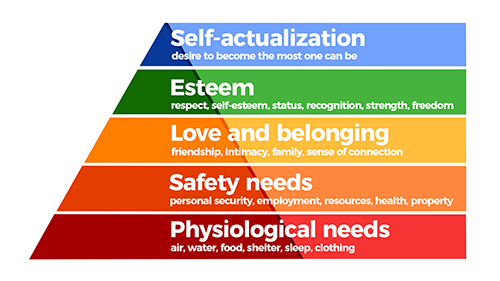
This hierarchy is a great analogy for many things. During this pandemic I have been doing a lot of thinking and fielding questions from colleagues around the world, and one of the questions that continues to come up is the question of how students can be successful in online learning. Obviously, there are many different types of online learning, and some would even argue that what most teachers are doing during the pandemic should not be called online learning, but instead be called "remote teaching". From an instructional design point of view, most online learning happens asynchronously, which takes careful planning and implementation in order to be successful. What many teachers are being forced to do is take what they were doing in their classrooms and move it into an online environment, but the online environment has some significant differences over the face-to-face environment that most teachers have worked in for years. These differences require making adjustments to what curriculum and materials teachers use, how they structure their lessons, and much more. As such, I have adapted Maslow's hierarchy of needs to illustrate the essential needs for successful online learning. I doubt I am the first to do so, but I also believe that other similar hierarchies lack some essential considerations when it comes to online learning. So let me present my hierarchy of needs for successful online learning.
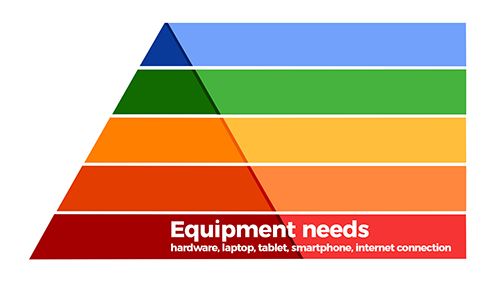
This may seem a bit obvious, but like physiological needs in Maslow's hierarchy, it often gets overlooked because people assume that for most people that need is met. Yet there are many parts of even so-called "first-world" countries where high-speed internet access is unavailable or very expensive. Satellite connections have improved but are still not as fast as hard-wired connections. At some point in the future we may be able to say that our infrastructure is such that everyone has a reliable internet connect, but that day is a long way off for now. The same is true for the hardware required to access the internet. In a crisis, like during this pandemic, people are being creative and using old smartphones and other similar devices that have wireless internet capability to access online materials. I have an old iphone 4s that my kids had to use at the very start of remote learning back in March because our family computer needed to be repaired. The iphone 4s worked in most instances, but because it could not be updated to the latest operating system offered by Apple, there were some applications that would not run, and some websites loaded so slowly as to make it useless in those cases. Efforts need to be made to provide technology to the most in need of online learning so they have access to the resources they need to be successful.
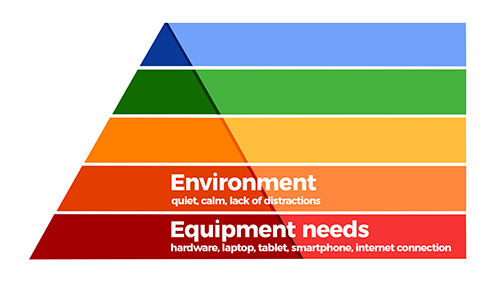
Once students have a way to access the online materials and resources, they need an environment that lets them focus on learning. Obviously, it must be a safe environment, but it must also be generally quiet, calm, and free of distractions. For some students, that might actually mean leaving their home, going some place that is more conducive to learning. I had a student who, due to a variety of reasons, had to go into the bathroom in order to find a quiet place. During classes, he had his camera off, so no one else really knew, but when he visited my office hours, he mentioned some of the struggles he was having and turned on his camera for me. Students will do what they have to do, but every effort should be made to provide that calm, quiet environment in order to promote effective learning.
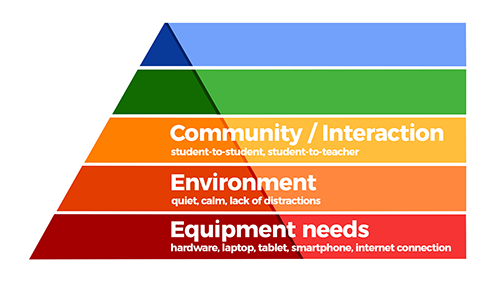
Interaction and Community is the next level, and this is something that is conspicuously lacking in most online learning environments. In a face-to-face learning environment, interaction and community building happen naturally when teachers talk to students before they start class, when students talk with each other in small group work, while they are waiting in the hall for the teacher to come and open the door, etc. Because it happens so naturally, and humans are generally geared for in-person communication, in online learning environments, it takes a lot of work to promote effective interaction and community building. In hybrid contexts, where there is a mix of live-sessions, maybe via Zoom or another video conferencing tool, it can be much easier to build community because there is still some person-to-person interaction, but teachers still need to plan community-building activiites into their live sessions and give students opportunities to interact with each other in both academic and social contexts. In asynchronous contexts, it is much more difficult to promote community-building, but definitely not impossible. It just takes concentrated effort and planning. One common method for promoting interaction is to use a discussion forum, and require students to respond to other students posts. In theory, this sounds great, but in practice it often does little to get students really talking to each other. They post cursory replies or struggle to find things to talk about. It's a little like putting two people in a room and forcing them to talk to each other. A better method might be to group students by common characteristics and let them gravitate toward topics they are interested in. For example, creating several discussion forums about various topics, and letting students choose the prompt they want to respond to. Then, when they are responding to other students, at least the other students they are responding to chose the same topic as they did, and there is a common interest than can spark conversation. In the Canvas learning management system, there are options to have students record a "media comment", either audio or video, directly into the discussion forum, allowing students to have an audio or video discussion. These are some great ways to increase interaction and build community.
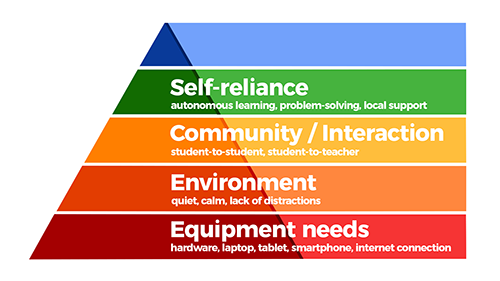
Perhaps one of the most prevalent issues with online learning is that, in general, it takes a certain type of person to be a successful online learner, and if you remove the pandemic from the equation, most people would not choose online learning as their learning format. Successful online learners are self-starters. They have the ability to solve problems on their own, or rely on their local support system (e.g. parents, roommates, sibling, friends) in order to help them solve problems. Unfortunately, not everyone inherently has these qualities, but now EVERYONE is forced into online learning and having to develop these qualities in order to be successful. Teachers can help by finding ways to help their students be autonomous learners by providing resources for them to track their own learning, and holding them accountable for doing so. For younger students, teachers can help train parents on how to use the technology so that parents can support their children when problems arise.
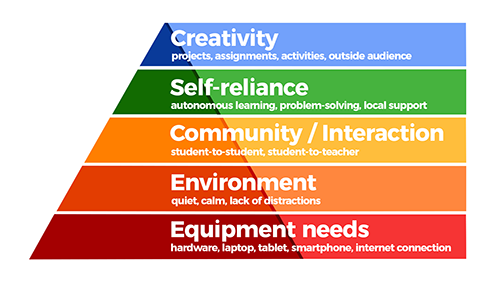
Creativity is where self-actualization would be on Maslow's hierarchy for a very specific reason. If students have met all the needs on the lower levels, but they are still doing what students typically did online before the pandemic, they will not learn very much. In most cases, teachers relied on face-to-face instructional time to conduct the meaningful experiences where students made connections with the material being learned and interacted with their peers, and used online resources for individual practice and rote memorization such as studying online flashcards or similar activities. Now that all instruction is being moved online, it is important to reassess how students spend their time learning and bring those meaningful learning experiences into the online learning space. Students need to be creative, and working on projects and assignments that are motivating and help them connect with what they are learning. They need to be reflecting, processing, synthesizing, evaluating, etc. that come from Bloom's taxonomy. I also included "outside audience" at this level because this is something I have found motivates and encourages my students. By outside audience I mean finding a way to connect what your students are learning to the word outside of the classroom. I typically will have my students in my writing class, for example, publish their essays on a blog, or one time we even published a book of their writing. It was amazing how much more time they spent on their writing when they knew it was going to be read by someone else beside the teacher. Bringing problems from their community into the classroom and having them look for solutions, and then present their solutions to community members is another way to bring in that outside audience. Now that their community is online, there are even more opportunities to connect with an outside audience, not just in their local area, but around the world.
